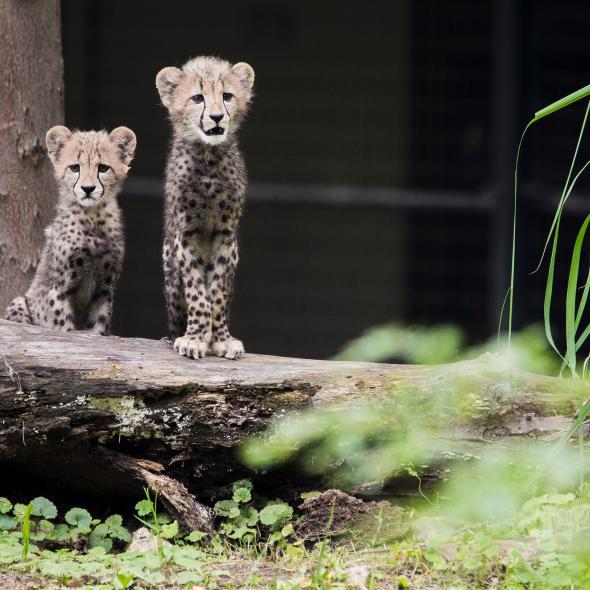Zoo animals are giving humans a run for their money in the assisted reproduction department. Mei Xiang, a giant panda at the National Zoo, gave birth to twin babies this past Saturday, thanks to artificial insemination. And earlier this month, scientists announced the birth of a bouncing baby black-footed ferret, conceived with cryogenically preserved sperm from a father who had died twenty years ago.
This is great, you’re thinking. Why can’t we just artificially inseminate all the endangered animals? Game over, extinction … right?
Well, no. But that line of reasoning isn’t too far off from what scientists were thinking back in the ’70s and ’80s. That’s when, inspired by successes in the livestock industry, researchers started freezing and stockpiling the sperm, eggs, and other tissues of endangered animals in “frozen zoos.” Farmers have successfully artificially inseminated cows for decades, and it’s common practice for prize horses and dogs. (And humans, of course.)
But it turns out wild animal insemination is a whole different beast.
Scientists, first off, simply don’t know how reproduction works for the vast majority of species. “We had to go back first to basic reproductive biology, because, of course, a cheetah is not a dairy cow,” says Pierre Comizzoli, a biologist at the Smithsonian Conservation Biology Institute.
Artificial insemination for cows has been successful because the livestock industry has poured millions of dollars and decades of research into studying them. But that’s just one species worth of research. With 6,264 endangered or critically endangered species on the IUCN Red List, scientists are spread thin trying to tease out the intricacies of their reproductive systems.
On top of that, science-mediated sex is really complicated (even more complicated than run-of-the-mill sex). “Artificial insemination is still an experimental model,” Comizzoli says. It works sometimes, but the odds of success aren’t great. So vials and vials of endangered animal sperm are just sitting around in liquid nitrogen in zoos across the country, waiting for the day the science catches up to the promise of their gooey contents.
Take the big cats. They’re especially challenging to artificially inseminate, says Adrienne Crosier, who’s been studying cheetah reproduction at the National Zoo for more than a decade. That’s because cheetahs don’t tend to produce good quality sperm samples. “A lot of cells in fresh ejaculate are motile and of good quality,” Crosier says, but what samples scientists can get from the small cheetah population are plagued by low sperm count and abnormally shaped cells. Mostly, that’s because cheetahs have an unusual lack of genetic diversity, thanks to a population bottleneck 10,000 years ago.
Female cheetahs aren’t helping out much either: Their estrous cycles are so irregular that Crosier has to administer hormones to reset them, and her team relies on male cheetahs to let them know when the females are in heat. Otherwise, she says, “it’s impossible for us to tell.”
Once scientists have collected a semen sample (a logistically complex procedure that may involve anesthetizing the animal), the sperm needs to be frozen and, when the time comes, thawed. “It’s asking a lot of these cells,” says Budhan Pukazhenthi, a Smithsonian scientist who works with ungulates like zebras, antelopes, and deer. Scientists basically pickle the sperm cells with a cocktail of antifreeze chemicals, which involves a delicate dance between lowering the temperature of the sperm and introducing the solution to keep sharp ice crystals from forming within the cell. Reanimating the sample involves reversing the process while controlling for temperature and thawing rates. “It’s almost like cooking,” Pukazhenthi says.
But, again, not all sperm is created equal. Giant pandas owe their human-orchestrated reproductive success to their hardy sperm: It’s resistant to cold, not fragile, and relatively easy to freeze and reanimate. Elephants, though? Scientists are still struggling to freeze the sperm and keep it alive after thawing. Cheetahs are somewhere in between—researchers have worked out a protocol to preserve sperm well, but insemination itself hasn’t gone so well. Out of 50 attempts or so, inseminated cheetahs have given birth to 11 litters. “You may have a perfect-quality sperm sample that’s just absolutely beautiful, and then your female doesn’t respond to the hormone, or vice versa,” Crosier says. “So some of it is all the stars aligning.” She and her team are working to increase those odds.
Still, artificial insemination has a ton of promise: Instead of transporting animals to breed between zoos and stressing them out in the process, it would be much simpler for everyone involved to just move their genes instead. Scientists can keep populations from becoming too inbred by pairing up genetically favorable couples. And a single sample can have a longer shelf life—and better staying power—than a single stud.
Using artificial insemination would be especially useful for cheetahs, who are extremely picky about their mates and rarely breed in captivity, says Crosier. “We need to be patient, but we also have species that need to be saved as soon as possible,” Comizzoli says. “This is kind of a race we have to win.”
Also in Wired:
Private Investigator Startup Exploits Ashley Madison Hack
You’re Using Your Camera’s Flash All Wrong
Scientists Get One Step Closer to a Universal Flu Vaccine
